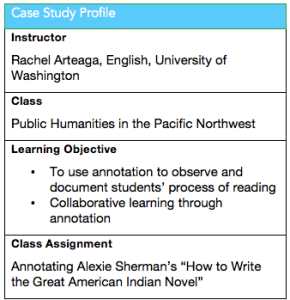 In teaching a section of introductory composition in a computer integrated classroom, Rachel Arteaga from the University of Washington developed a lesson plan for collaborative online annotation of texts. She asked students to work in groups of three, with specific annotation tasks for each group, to close read a poem by Sherman Alexie. By focusing each group on a specific task, they collaboratively built a set of annotations that covered a number of categories of textual analysis.
In teaching a section of introductory composition in a computer integrated classroom, Rachel Arteaga from the University of Washington developed a lesson plan for collaborative online annotation of texts. She asked students to work in groups of three, with specific annotation tasks for each group, to close read a poem by Sherman Alexie. By focusing each group on a specific task, they collaboratively built a set of annotations that covered a number of categories of textual analysis.
The specific annotation tasks for the six groups were as follows:
- Group One: Vocabulary: Work together to locate unfamiliar or richly descriptive words to define for the class. Use Merriam-Webster or another authoritative dictionary to support your definitions, and include the link to the dictionary definition in your annotation. In your own words, in contemporary language, place the word into an example sentence to help to demonstrate its meaning. (This must be original: do not copy and paste example sentences from the dictionary.)
- Group Two: Cultural / Literary / Geographical References:What are the explanations for these references? What is the background information that a new reader of Alexie’s work would need to fully understand the allusions he is making? Include external links to sites that authoritatively explain these names, places, etc.
- Group Three: Claims:Is the speaker making any arguments in this poem? Is he trying to persuade us to see the world from his point of view? Remember, he may make claims about himself, about humanity in general, about race, the environment, history… Each group member must locate at least one claim and the evidence (if any) that the narrator gives to support his claim.
- Group Four: Tone / Language / Syntax:How would you describe the tone of this poem? Annotate and describe at least one section that supports your answer. How would you describe Alexie’s use of language (the words he is choosing for descriptions) in this poem? Annotate and describe a section that supports your answer. How would you describe the syntax (sentence construction) at work here? Annotate and describe a section that supports your answer.
- Group Five: Social Contexts:Literary critics often read with an attention to gender, race, and class. To this list we might add religious and secular faiths, political statements, and any other aspects of social life or identity one can notice in the text. You may choose to pose questions about these issues in your annotations, rather than attempt to write a finalized idea. Questioning elements of the text is as important as defining them.
- Group Six: Impact: How does this poem strike you? Find a section that you find troubling, emotionally moving, or funny (these are just some examples to get you started) – a section that is somehow powerful or revealing to you. Why does this section stand out? What, as precisely as possible, makes the section function in this way – what makes it have this effect on you as a reader?
After the assignment, Arteaga reported that “student reaction to this platform was overwhelmingly positive.” Students not only found Annotation Studio very user-friendly, but also remarked how “[b]eing able to see the class’ comments is a really cool feature,” and that the “clean layout” “really benefitted them because it allowed them to go directly to the text and to really engage that text.” Students further added that it was “very helpful to be able to see other people’s annotations and ideas to further progress my own thoughts and understanding of the reading”.
Arteaga also noted that students “took away from this how individualized annotations approaches can be when students are working on their own. So ultimately they will leave this class and be writing papers for other classes, and they will have so much more insight in how other people annotate that they can adapt into their own.”

